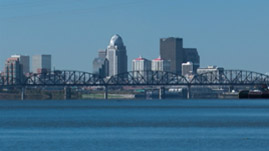Teachers' Domain - Digital Media for the Classroom and Professional Development
User: Preview


Tunneling for Water is funded by the Louisville Water Company.
This video features “Science Steve” of Louisville Water Company and his animated friend Tapper explaining the importance of the Ohio River as a natural source of drinking water. He describes the river’s geologic origin as a result of glaciation and the different rock layers or strata exposed when the water company dug a tunnel beside the river to access the water. The video ends with an introduction of concepts underlying this riverbank filtration system such as how an aquifer works and the meaning of the term “filtration.”
This resource is part of the Louisville Water Company: Tunneling for Water collection
Tunneling for Water: Teacher Materials (Document)
One of the major population centers along the Ohio River is the city of Louisville, Kentucky. Every day, Louisville Water Company (LWC) produces millions of gallons of drinking water for its customers by pulling surface water from the Ohio River.
The Ohio River is an amazing natural water resource for Louisville as well as other cities and towns throughout the Ohio River Valley. However, its other uses—for transportation, industry, and recreation—can result in water pollution and contaminants that make it challenging to use the river to supply drinking water.
To make sure that the surface water is safe for people, the LWC sends it to a treatment plant where it is filtered to remove contaminants and sediment. In looking for a more efficient and “greener” way to produce drinking water, the company began investigating a process called riverbank filtration that allows for the use of groundwater instead of surface water in the municipal water system.
In 1999, the LWC began riverbank filtration at their B.E. Payne Plant with one well that pulls 20 million gallons a day from an aquifer. An aquifer is an underground layer of rock, gravel, sand, or soil that holds water. In this case, the aquifer is located near the bank of the Ohio River, so the river water filters through the bank into the aquifer.
Based on the success of the Payne Plant, the LWC decided to expand the project by digging four additional wells and a mile-long collection tunnel that can produce up to 70 million gallons of water a day from the riverbank aquifer. The videos in the Tunneling for Water collection document this engineering feat and look at science and engineering concepts related to the project.
The process of riverbank filtration has several advantages over pulling surface water from the river. They include the following:
The LWC tunnel and well system—the first of its kind in the world—consists of four wells that collect water from the aquifer. They are located above the tunnel, which is 150 feet below the surface of the ground. When water collects in the wells, gravity causes it to flow down into the tunnel. Then electric pumps pull the water from the tunnel back to the surface, where it is processed and distributed to Louisville households and businesses.
 Loading Standards
Loading Standards